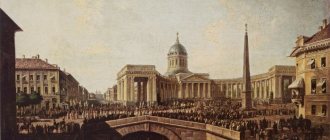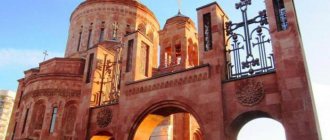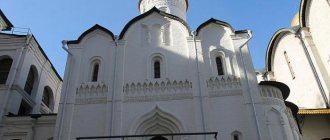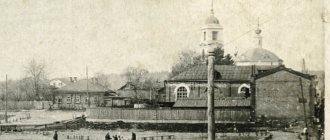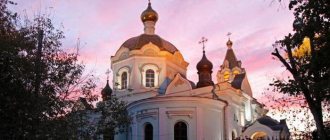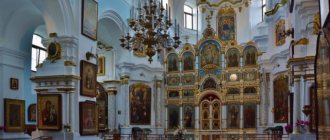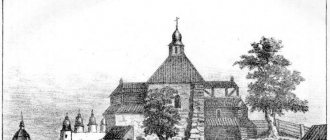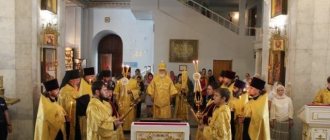In 2005, the city of Novocherkassk celebrated a double anniversary - two hundred years since the founding of the city and the foundation of the main Cossack temple here. The Ascension Cathedral in Novocherkassk was restored especially for this date. The appearance was restored in accordance with the drawings and drawings of the early 20th century. The military cathedral of the Ascension is considered the third largest in Russia after the Moscow Christ the Savior and St. Isaac's Cathedral.
Ascension Cathedral (Novocherkassk)
The temple is visible from afar; it is clearly visible from the Tuzlov and Aksai rivers, which wash the hill where Novocherkassk is located. The bell tower rises 74.7 meters high. The height of the dome is in seventh place in Russia. The cross on the main dome is inlaid with rock crystal and cut with diamonds. The light, refracted in the diamond facets, shines like the sun, reflected in the golden domes.
The Ascension Cathedral in Novocherkassk is famous for its interior decoration. The iconostasis and floors are decorated with marble, specially ordered from France and Italy. The variety of frescoes is amazing. The depicted faces of saints, illuminated by candles, look out from the walls and columns. The choirs are decorated with paintings depicting the most significant events from the history of the Don Cossacks.
Architectural lighting
Architectural lighting of the Ascension Cathedral On September 10, 2005, in the city of Novocherkassk, the architectural and artistic lighting of the Military Ascension Cathedral was switched on.
The project provides for the use of lamps that create narrowly directed beams of light, as well as floodlights. Thanks to the use of flood light in the project, specialists achieve the transfer of the overall volumetric-spatial form of the architectural structure. Narrowly directed beams of light allow you to highlight decorative elements. The lamps installed in the five belfries will create the effect of a “lamp” - glowing from the inside. What makes this object unique is the projection on the façade of the cathedral, made using equipment from the Austrian company Pani. The automated slide changing module is designed for 32 pictures.
Projections on biblical themes, as well as the use of works by masters of Flemish painting (Paul Rubens' Ascension of Christ) create the impression of a divine presence. The inclusion of images is carried out on Christian holidays. Another feature of this equipment is that the projector can be installed at an angle to the surface on which it is projected. The projector power is 6 kW, which gives a fairly bright image even in the twilight period. A special optical correction system corrects keystone distortion, and the condenser lens system provides a clear and large image.
You can verify the uniqueness and splendor of the Ascension Cathedral by watching the proposed video.
Temple-tomb
At the beginning of the last century, the Ascension Cathedral in Novocherkassk had a unique heating and ventilation system; in those years it was a huge breakthrough in a technical sense. Bold engineering developments made it possible to create a comfortable atmosphere inside the cathedral and ensure the complete preservation of paintings, frescoes, and iconostasis. Nowadays, unfortunately, this system has been lost.
The lower part of the temple is a tomb, consecrated in honor of the Intercession of the Virgin Mary. Here are sarcophagi made of Italian and French marble. They contain the remains of generals - heroes of the war of 1812: Efremov, Orlov-Denisov, Baklanov; the founder of the Don capital Platov, Archbishop John Dobrozrakov.
A baptismal sanctuary is also located here. The depth of the basement is 15 m, an underground passage from it leads to the House of Officers.
Current state[edit]
Architecture[edit]
The Novocherkassk military Ascension Cathedral with six domes was built in the New Byzantine style. Made of brick. Its technical characteristics are: total height inside the temple - 51.2 m, total height outside with a cross - 74.7 m, length inside - 72.5 m, length outside - 76.8 m, width inside - 57 , 6 m., width outside - 62 m., diameter of the dome inside - 18 m., diameter outside - 21.5 m. One service can accommodate 5 thousand worshipers. The cathedral has two basements - a lower and an upper with a total depth of about 15 m. The weight of the concrete vault, created according to the Monier system (without the weight of the main cross) is more than 182 tons.
Two cast-iron staircases lead to the premises of the lower basement: one spiral with 70 steps and 3 landings, the other with 51 steps and 5 flights. A cast-iron staircase with 9 flights of 62 steps and 9 landings leads to the choir. And to the bell tower there is a staircase of 4 flights with 48 steps and 5 landings, and then a spiral staircase with 56 steps. In total, up to 200 steps lead to the bell tower.
The magnificent wall paintings of the temple have been partially preserved.
Necropolis[edit]
After a lengthy discussion, by resolution of the Holy Synod No. 6340 of August 14-24, 1910, it was decided to bury the ashes of the heroes of the Don Army in the sarcophagi of the cathedral tomb: Lieutenant General I. E. Efremov, Adjutant General Count V. V. Orlov-Denisov and Lieutenant General Ya. P. Baklanov. The synodal resolution of August 17-19, 1911 also allowed the remains of the ataman of the Don army, Count M. I. Platov, to be buried in the tomb. The reburial of all four heroes followed on October 4 of that year. At the same time, the ashes of Archbishop Donskoy John (Dobrozrakov), especially beloved by the townspeople, were placed here, whose body and clothes were found incorrupt.
During the Soviet period, there were rumors that the graves were discovered and desecrated in the early years of Soviet power. When on March 1, 1992, a commission formed on the instructions of the Don Ataman S.A. Meshcheryakov from representatives of the Cossacks opened ancient burials, they found both parts of the remains and construction debris, fragments of the iconostasis, etc. The Cossacks decided to put the Don shrines in order and to solemnly rebury the remains of famous people of the Don, which followed on May 15, 1993.
Story. First Temple
The city was founded in 1805, at the same time the Ascension Cathedral of Novocherkassk was founded. For some now unknown reasons, construction began only in 1811. The work was supervised by the author of the project himself - a staunch supporter of classicism - Italian architect Aloysius Rusca. The architect left Russia in 1818, the work was not yet completed, and our master Amvrosimov continued the work. Unfortunately, the construction did not end successfully.
In 1846, when work was underway on the construction of the dome, a large part of the facade collapsed. The magnificent construction site instantly became a pile of ruins. There was no one inside the building at that time; it was a holiday, so there were no casualties. At the same time, this was reported to the king. A commission was sent to the site, which revealed gross errors in the architectural design, as well as during construction. They caused the building to collapse. In addition, the building materials used were of very poor quality. Forty years of work went to waste.
The Great Patriotic War and attempts at restoration
The temple opened again when Novocherkassk was occupied by the Germans. In the summer of 1942, the “Bulletin of the Novocherkassk City Council” reported on the “celebration of the day of liberation from the Bolsheviks.” In particular, they talked about the service in the cathedral.
Be that as it may, after the liberation of the city from the fascist invaders, the Ascension Cathedral was not closed. However, the basements continued to be used for food warehouses.
In the middle of the last century, the question arose about the restoration of temple paintings. Leningrad artists were invited, and they were able to do something. True, due to a lack of funds, instead of gold leaf, the restorers used ordinary bronze paint.
The need for “external” restoration was discussed in the late 1970s. But there was still no money for professional craftsmen, so they invited artisans. As a result, it was only possible to plaster and paint part of the western façade orange.
Meanwhile, the frescoes continued to gradually crumble. Adding to the headache was the water, which regularly flooded part of the basement and the underground passage leading to the former Bishop's House. It was not possible to pump it out effectively, and experts decided that it was better not to do this at all, explaining this conclusion by the fact that if the water balance was disturbed, the destruction of the cathedral would begin.
Second try
After some time, work on the construction of the temple resumed. The construction was entrusted to the experienced architect Valprede. The project was drawn up anew and was accepted according to the most stringent technical criteria. But evil fate was inexorable this time too. At the same stage of work in 1863, a collapse occurred in exactly the same way as 17 years earlier. What is this? Omen or God's will? Remains a mystery. The next commission established the cause was excessive haste during construction. However, the architect himself was not blamed for this, because he repeatedly notified the government in writing about the rush in the work, which would affect the quality. He was simply forced to obey the orders of local authorities and Cossack atamans.
Start of construction
But how can the Cossacks live without the temple of God? Before the decision to build the temple was made, heated debates took place: should we restore the destroyed building or dismantle it completely and begin new construction? They decided to completely clear the place; this was done in 1882. In 1891, the Cossacks decided to build a new Ascension Military Cathedral (Novocherkassk).
The project was approved by Emperor Alexander II. The author of the third project of the Ascension Church was the Don architect of the Cossack army, Yashchenko. Shortly before this, he was awarded the title of academician. Unfortunately, he was not destined to see his brainchild. He died in 1893. The work at this time was at the foundation construction stage.
The new temple was built under special supervision. Past sad experiences have taught me a lot. The new manager, Zlobin, discovered serious violations while laying out the basement. Construction was suspended again, thorough checks were carried out, and work was supervised by higher authorities. No irresponsibility was allowed in construction.
Application of engineering technologies. Consecration of the temple
Engineer-Colonel Limarenko was called in to help with the construction, who just at that time had completed the construction of the cathedral in the Kovno fortress. He carried out reconnaissance of the basements, pointed out errors in the construction and was appointed construction manager. Here he first proposed the use of concrete and reinforced concrete structures. And this is not the only innovation that was used when the Ascension Cathedral was built; Novocherkassk had its own brick factory, where they produced 2 million bricks per year. A water pipeline was built to supply water from the river to the construction site. They also built their own power plant. It also built its own laboratory, where construction materials were tested for quality. At the turn of the 19th and 20th centuries, the construction of the temple was approached with all seriousness, which was supported by the innovations of technical progress.
In 1901, stucco and plastering work was completed. equipped the temple with a heating and ventilation system. So, after only ten years, a 75-meter religious building rose up from the basement work, which could accommodate 5 thousand worshipers. Construction costs then amounted to 2 million rubles. Nine bells were lifted manually by ropes. Every Novocherkassk resident could participate in this event.
In May 1905, a hundred years after the foundation of the first temple, the consecration of the Novocherkassk Cathedral took place. Cossacks came from all the villages for such a grandiose event. All their lives they remembered and told their descendants about the beautiful temple, which was named “The Second Sun of the Don”.
Years of atheism
During the years of atheistic madness under Soviet power, the Ascension Military Cathedral in Novocherkassk was not spared from troubles. In the thirties, the temple was closed, services stopped, and copper sheets and crosses were removed from the domes. In the most beautiful church in Russia, the Soviets set up a warehouse for flammable materials. In 1942, the temple was opened for services when the city was under occupation.
After World War II, food was stored in the cathedral's basements: flour, grain, sugar, beer malt. Services were sometimes held in the upper church on major church holidays. The year 1953 became a saving year for the Ascension Church in Novocherkassk. After the death of Joseph Stalin, the crumbling building, which has historical and architectural value, came to the attention of scientists. Having assessed the significance of the facility, the authorities gave the go-ahead for interior and façade repair work. In 1974, the temple became an architectural monument, first of local significance, and in 1995 - of federal significance.
How are the services held?
Morning services begin at 7:00 and evening services at 18:00. All-night vigils are also held at evening services. Every month, some changes may be made to the general order in accordance with the church calendar.
Every weekday at 12:00, prayers for everyday needs are held:
- Monday - about the sick;
- Tuesday - from witchcraft;
- Wednesday - about family well-being;
- Thursday - about material well-being;
- Friday - about those suffering from the disease of drunkenness.
"Second Sun of the Don"
The Holy Ascension Cathedral of Novocherkassk shone like the sun again in 2010-2011. The domes were then covered with gold sheets, the cross was treated with rock crystal stones. In the spring of 2014, by Decree of Patriarch Kirill, the Church of the Ascension received the status of the Patriarchal Ascension Military All-Cossack Cathedral. Now this temple has become the second Patriarchal Cathedral in Russia. The first is the Assumption Cathedral in the Moscow Kremlin.
Anyone who visits the temple in the evening cannot take his eyes off the majestic beauty of the temple, which is enhanced by the lighting. An original modern lighting system projects biblical scenes onto the white walls of the building. General illumination gives the temple a more solemn and majestic appearance. Internal restoration work continues, the temple will soon regain its true original appearance.
Patronal holidays
Patronal feasts are the days of remembrance of the saints whose names the chapels of the church bear, as well as the days of foundation and consecration.
Solemn services are accompanied by the singing of the cathedral choir under the direction of regent Galina Moskalenko:
The main patronal holiday, which is celebrated on May 17, is the day of the Ascension of the Lord. On this day, a festive divine liturgy is celebrated. September 17 about the icon of the Mother of God Hodegetria - the main revered shrine of the Ascension Cathedral. The southern aisle of the cathedral was consecrated in the name of this icon. The celebration is accompanied by a solemn service. The Feast of the Intercession of the Most Holy Theotokos, in whose name the Lower Altar of the Church is consecrated, celebrated on October 14. The holiday of Easter (Resurrection of Christ), whose name is given to one of the chapels of the cathedral.
Temple shrines
The Ascension Church is famous not only for its architectural perfection and the richness of its interior paintings. The history of Novocherkassk is connected with the Don Cossacks; the city has always remained a true believer and preserves the glory of miracle-working icons and the relics of holy saints. The metrical books of the Ascension Cathedral in Novocherkassk can reveal many secrets about the bygone generation.
Everyone who finds themselves in the temple can venerate the prayed images, which became famous for the manifestations of miracles. Such shrines include the icons of the Mother of God: “Aksai”, “Don”, “Seeking the Lost”, “Life-Giving Spring”.
In the Church of the Ascension there is a tomb where the ashes of St. John Dobrozrakov rest. Believers throughout the country know the power of prayer that is offered in these holy places.
The schedule of services in the Church of the Ascension is no different from many Russian churches. But the spirituality and solemnity that hovers here under the arches puts the cathedral in one of the first places in Russia. It belongs to him by right, and everyone who has been here will confirm this.
Interior decoration
The interior of the Ascension Church is distinguished by its majesty and solemnity: high arches and vaults, marble iconostases and icon cases flooded with light, walls painted with Christian themes. The floor is covered with 5,600 slabs of marble in pink, grey, green and white.
View from the main entrance
The central dome of the Ascension Cathedral: view from the inside
Altar of the Ascension Cathedral
The ancient unique frescoes are of particular value; there are about 200 of them in the cathedral and they have been perfectly preserved to this day. None of the visitors to the temple, parishioners and tourists, are left indifferent by the beauty and richness of the interior decoration of the cathedral.
Video: worship in the cathedral, an overview of the entire temple from the inside
